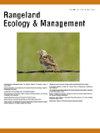秘鲁东北部本地灌木种对养牛的营养潜力
IF 2.4
3区 环境科学与生态学
Q2 ECOLOGY
引用次数: 0
摘要
在秘鲁,天然草和灌木是牛饲料的主要来源;然而,用作饲料的灌木物种的营养品质通常仍在确定中。因此,本研究旨在确定秘鲁亚马逊地区主要的原生灌木物种及其对牛的营养潜力。通过对该地区养牛户的调查,选择了灌丛植物,并测定了每种植物的色相特征。事实上,14科21种被确定为牛饲料的主要灌木。其中,以菊科植物最多(6种),总蛋白含量超过18%的植物有10种,消化率超过60%的植物有19种。主成分分析(PCA)表明,前两个维度解释了60.7%的总变异,其中消化率、中性洗涤纤维、酸性洗涤纤维和蛋白质是影响最大的因素。此外,通过聚类分析将牧草按其营养特性划分为4类,为根据牧草的品质选择牧草提供了坚实的依据。毛蕊豆蔻(Myriocarpa stipitata)的总蛋白含量最高,为30.3%,消化率最高,为89.2%,是秘鲁东北部最有潜力饲养牛的灌木树种。本文章由计算机程序翻译,如有差异,请以英文原文为准。
Nutritional potential of native shrub species for cattle feeding in northeastern Peru
In Peru, natural grasses and shrubs are the primary sources of cattle feed; however, the nutritional quality of shrub species used as forage is generally still being determined. Therefore, this research aimed to identify the main native shrub species and the nutritional potential of each species for cattle feeding in Amazonas, Peru. The shrubs were selected through surveys of cattle farmers in the region, and each species' bromatological characteristics were determined. In fact, twenty-one species from 14 families were identified as the main shrubs used for cattle feed. Among them, the Asteraceae family reported the highest number of species (6). The percentage of total protein was higher than 18% in 10 plant species, while the percentage of digestibility exceeded 60% in 19 species. Principal component analysis (PCA) revealed that the first two dimensions explained 60.7% of the total variability, with digestibility, neutral detergent fiber, acid detergent fiber, and protein being the most influential factors. In addition, cluster analysis grouped the species into four groups differentiated by their nutritional characteristics, providing a solid basis for selecting forage species according to their qualities. Myriocarpa stipitata (Urticaceae) presented the highest percentages of total protein (30.3%) and digestibility (89.2%), being the shrub species with the greatest potential for cattle feeding in northeastern Peru.
求助全文
通过发布文献求助,成功后即可免费获取论文全文。
去求助
来源期刊

Rangeland Ecology & Management
农林科学-环境科学
CiteScore
4.60
自引率
13.00%
发文量
87
审稿时长
12-24 weeks
期刊介绍:
Rangeland Ecology & Management publishes all topics-including ecology, management, socioeconomic and policy-pertaining to global rangelands. The journal''s mission is to inform academics, ecosystem managers and policy makers of science-based information to promote sound rangeland stewardship. Author submissions are published in five manuscript categories: original research papers, high-profile forum topics, concept syntheses, as well as research and technical notes.
Rangelands represent approximately 50% of the Earth''s land area and provision multiple ecosystem services for large human populations. This expansive and diverse land area functions as coupled human-ecological systems. Knowledge of both social and biophysical system components and their interactions represent the foundation for informed rangeland stewardship. Rangeland Ecology & Management uniquely integrates information from multiple system components to address current and pending challenges confronting global rangelands.
 求助内容:
求助内容: 应助结果提醒方式:
应助结果提醒方式:


